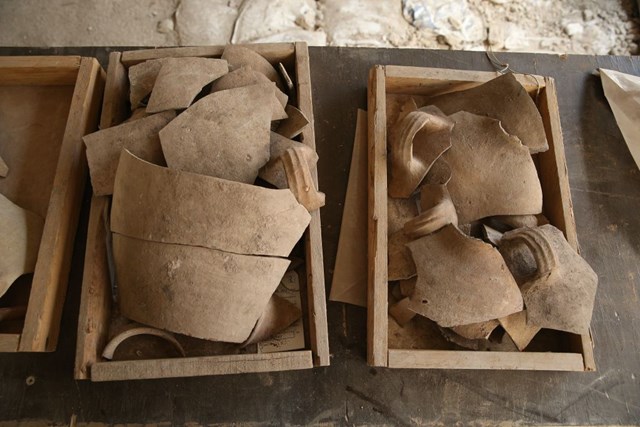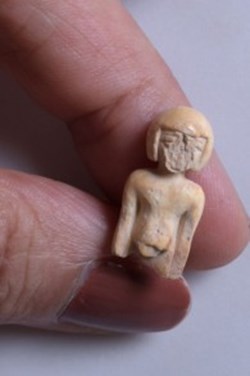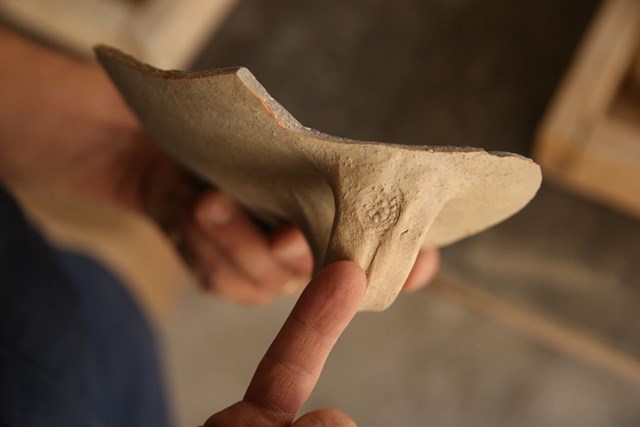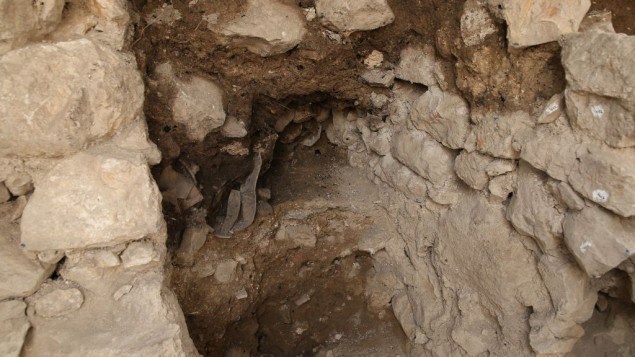The structure in which shattered jugs were found during the summer 2017 Israel Antiquities Authority dig, attesting to the destruction. (Eliyahu Yanai, Courtesy of the City of David Archive)
On the eve of the Hebrew commemoration of the destruction of the Temples, archaeologists discover remnants of a blaze indicating the city was grander than thought
New finds in the City of David confirm the veracity of the biblical account of the Babylonian capture and conquest of First Temple period Jerusalem. The event is commemorated next Tuesday on the Hebrew date Tisha B’av (August 1) in a day of fasting and mourning, Israeli experts said.
According to Israel Antiquities Authority archaeologist Dr. Joe Uziel, co-director of the current excavations at the City of David, findings discovered in the site’s eastern slope, including a row of 2,600-year-old rooms and their contents — all covered with visible layers of charcoal ash — aid in understanding the days leading up to and the act of the destruction.
Within the collapsed rooms were uncovered rare artifacts, including a unique, apparently Egyptian, ivory statue of a nude woman, and smashed pottery jars with a rosette seal which was in royal use during the final decade before the fall of the First Temple, according to co-director Ortal Chalaf.
“These seals are characteristic of the end of the First Temple period and were used for the administrative system that developed towards the end of the Judean dynasty. Classifying objects facilitated controlling, overseeing, collecting, marketing and storing crop yields. The rosette, in essence, replaced the ‘For the King’ seal used in the earlier administrative system,” said Chalaf.
Additionally, charred remains of wood, grape seeds, and fish scales and bones will be carbon dated by members of the interdisciplinary cooperative team of Israel Antiquities Authority archaeologists and Weizmann Institute scientists Elisabetta Boaretto and her postdoctoral fellow Johanna Regev, who were present at the dig site.
According to biblical descriptions, in 586 BCE, the Babylonian king Nebuchadnezzar vanquished the Judaean king Zedekiah and razed his capital city, Jerusalem. The Babylonian captain of the guard Nebuzaradan was dispatched into the city, where, as told in the Book of Jeremiah, he “burned the house of the Lord, and the king’s house; and all the houses of Jerusalem, even every great man’s house, burned he with fire.”
At the dig site, the rampant destruction caused by a fiery inferno is clearly seen. Burnt charcoal layers of destruction preserved flooring and utensils in situ, giving a stark picture of the immediacy of the blaze.

Shattered jugs, attesting to the First Temple-era destruction in the City of David. (Eliyahu Yanai, Courtesy of the City of David Archive)
This is not the first time that remains of the Babylonian First Temple destruction were found in the City of David. What is interesting in the current dig, located beyond what is commonly thought of as Jerusalem’s city limits during the First Temple, is that not all the excavated buildings of this period show the intense destruction layer.
“It seems like not all of the buildings were destroyed in a single event. It seems that some were destroyed and others were abandoned and left,” said Uziel in an IAA video.
According to Uziel, these new findings correlate with those presented by the British archaeologist Kathleen Kenyon, who excavated the site for seven seasons in the 1960s when it was still under Jordanian control and found First Temple building there.

The archaeologist Yigal Shiloh, who excavated swaths of the City of David after Kenyon, wrote in a Biblical Archaeology Review article in 1979 following his first season that one of the most important conclusions of Kenyon’s work is that “the fortification wall-lines of the Bronze and Iron Ages (Canaanite and Israelite Jerusalem) lay much further down the eastern slope of the ridge than previous investigators had thought.”
According to the current team of IAA archaeologists, Jerusalem underwent constant growth throughout the Iron Age. This was expressed both in the construction of numerous city walls and the fact that the city later spread beyond them.
“Excavations carried out in the past in the area of the Jewish Quarter have shown how the growth of the population at the end of the 8th Century BCE led to the annexation of the western area of Jerusalem. In the current excavation, we may suggest that following the westward expansion of the city, structures were built outside of the wall’s border on the east as well,” said the IAA.
Prior to her death in 1978, Kenyon told archaeologists that she felt there were few further studies that could be made in the area for lack of surviving artifacts.
“Our excavations have produced a plan of earliest Jerusalem that can only be disproved if further excavations produce more factual (by which I mean stratigraphical) evidence. I do not believe that opportunities for such excavations survive, mainly because of ancient quarryings, but also modern building activities. If they do, I wish the excavators luck.”
In fact, following Kenyon’s 1960s digs, subsequent teams were not able to find more First Temple evidence in the City of David until 1976, when the first excavations by Israeli archaeologists took place. (Babylonian-era arrowheads were, however, discovered by Hebrew University Prof. Nachman Avigad in the Old City in 1975 — the first artifacts found of the two-year Babylonian siege.)
Archaeologist Eilat Mazar describes in an essay for BAR the loss of hope experienced by archaeologists of her grandfather Benjamin Mazar’s generation when “he came upon a portion of a public building on the far southeastern edge of the excavation. It was preserved to a considerable height and contained numerous charred vessels—burned in the horrible destruction that the Babylonians inflicted on Jerusalem in 586 BCE.”

Jug handles with the rosette seal used by the administrative system at the end of the Judean Kingdom recently found in the City of David, 2017. (Eliyahu Yanai, Courtesy of the City of David Archive)
Mazar’s further revolutionary findings included dozens of vessels, five large ornamented bowls, a small pendant with an image of Sekhmet, the Egyptian goddess of war, and a jar handle bearing a seal impression inscribed with the name of a woman: “Hannah daughter of Azariah.” In a second room, which Mazar wrote was partly destroyed by later construction, her grandfather found a rosette storage jar, the type that was recently found by the current IAA team as well.
The new row of buildings discovered recently by the IAA archaeologists was found beyond the wall delineating the eastern city border.
As they continue to process the findings, Uziel voiced questions the team is pursuing. “Are we outside the city? Are we excavating an external quarter? Are these domestic buildings?” asked Uziel.
Or, in other words, just how large and widespread was the destruction of Jerusalem, which is commemorated next week?

